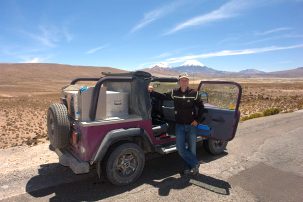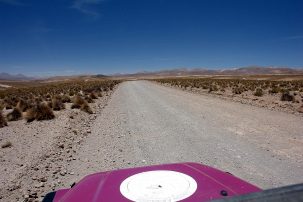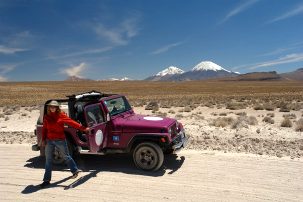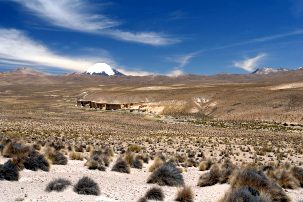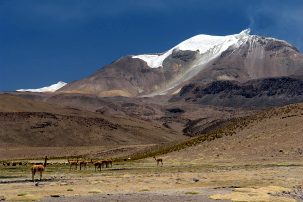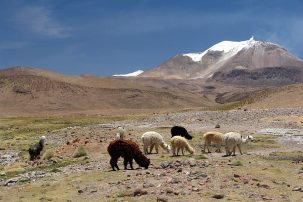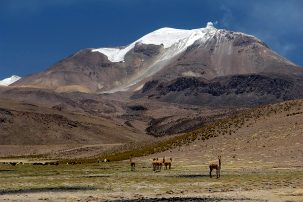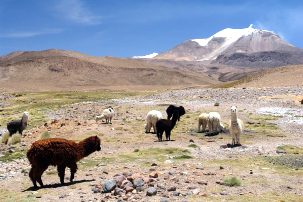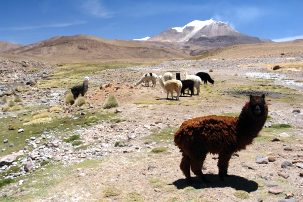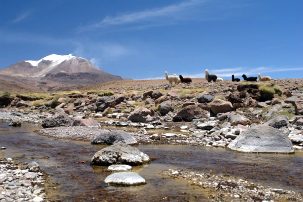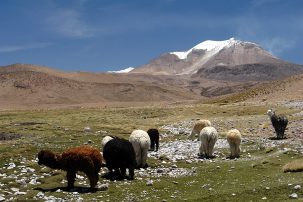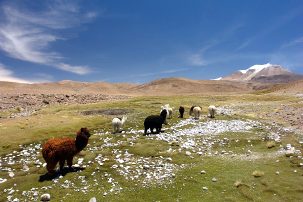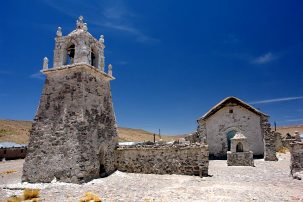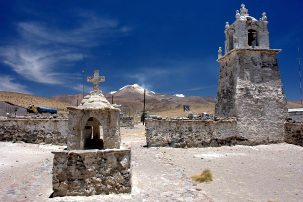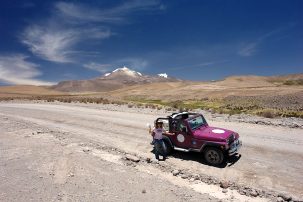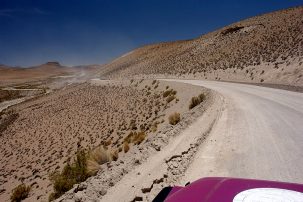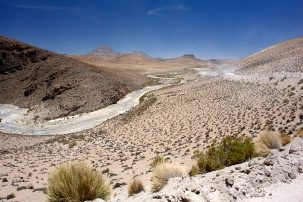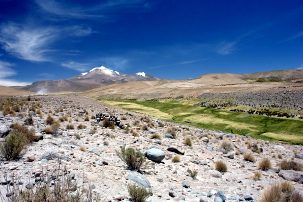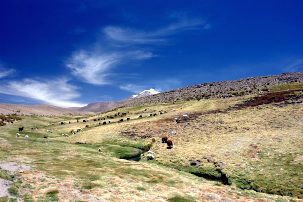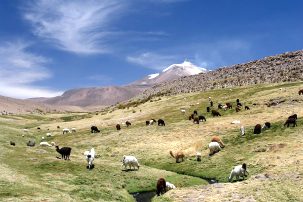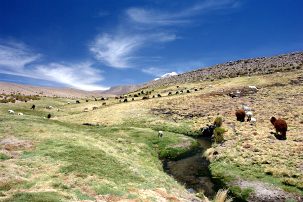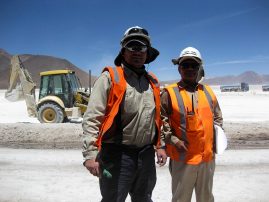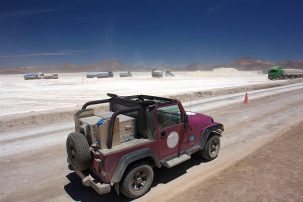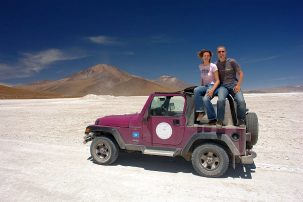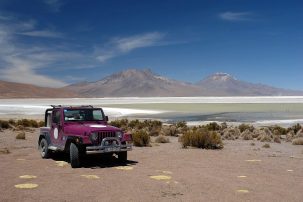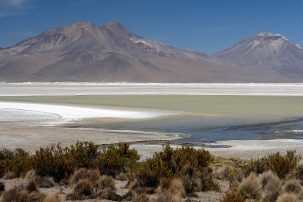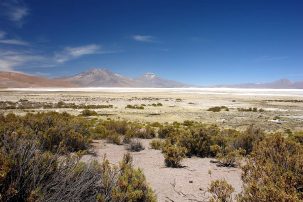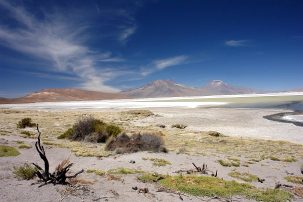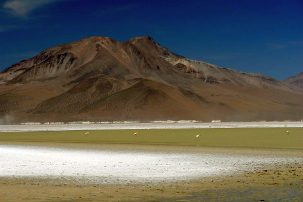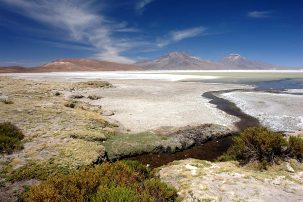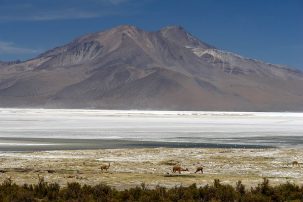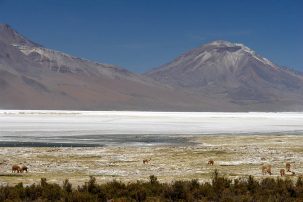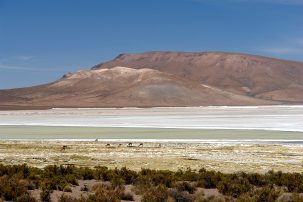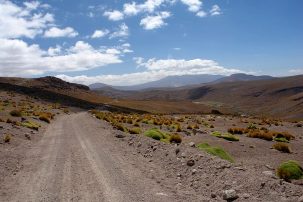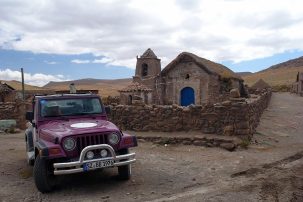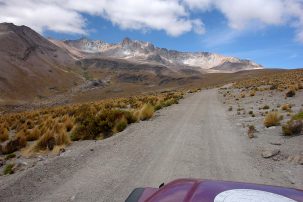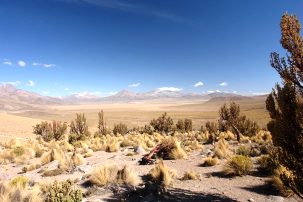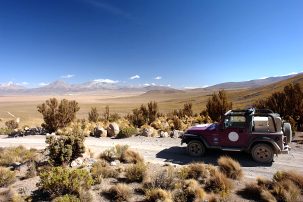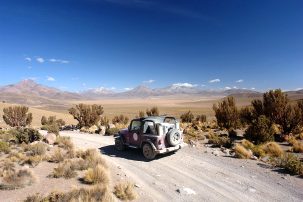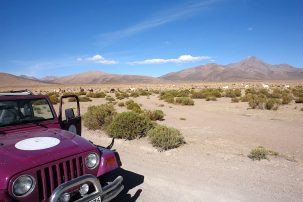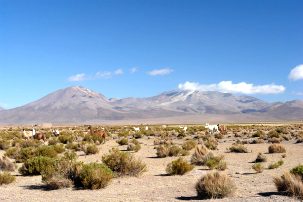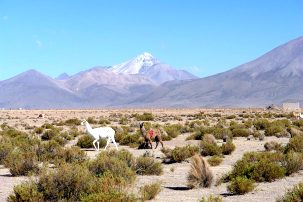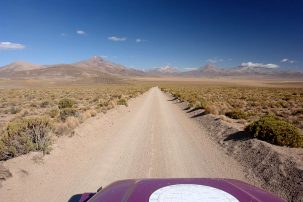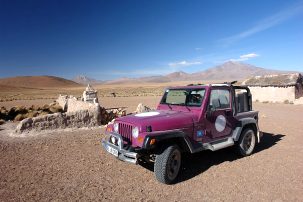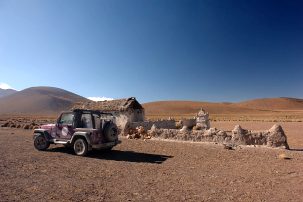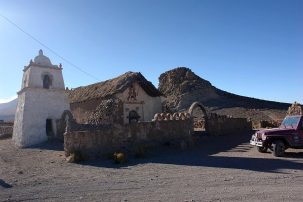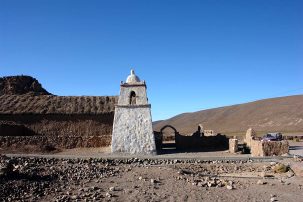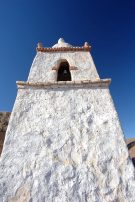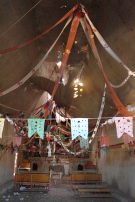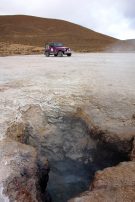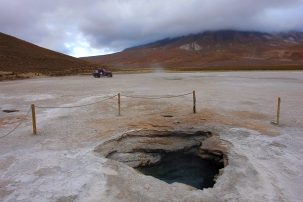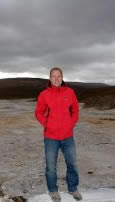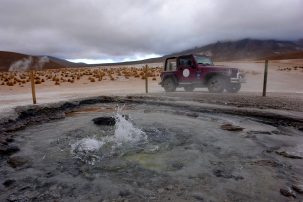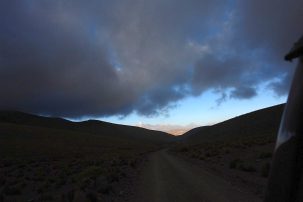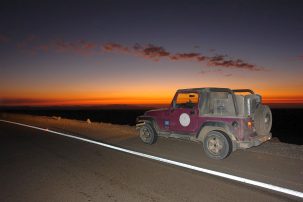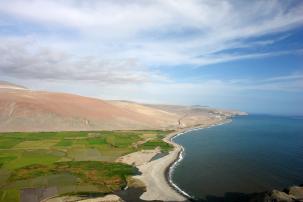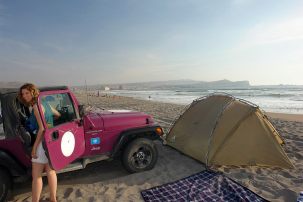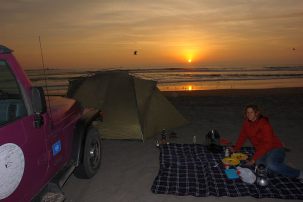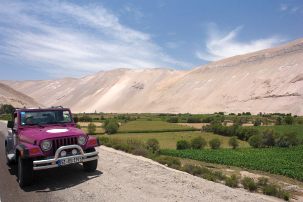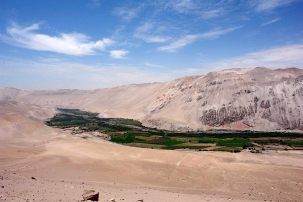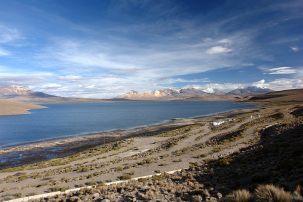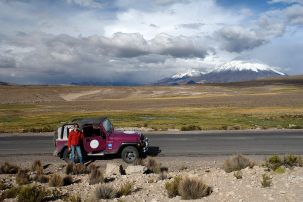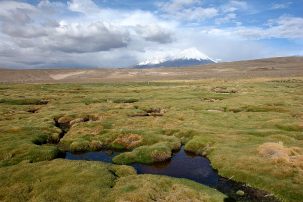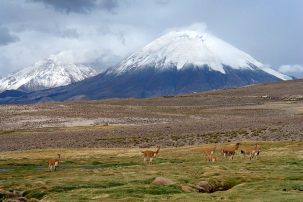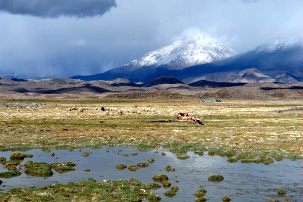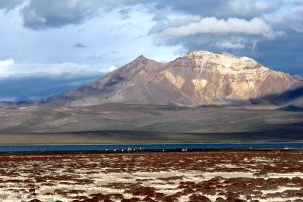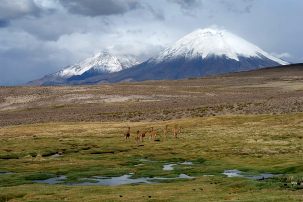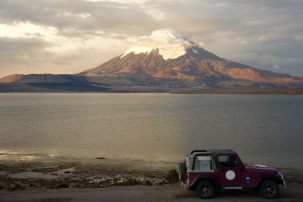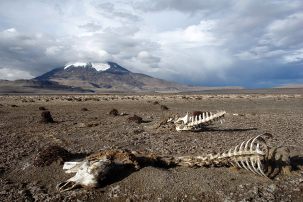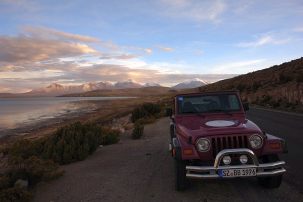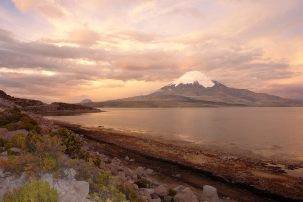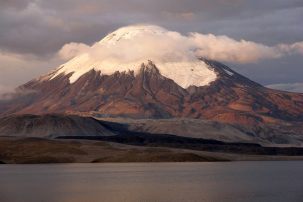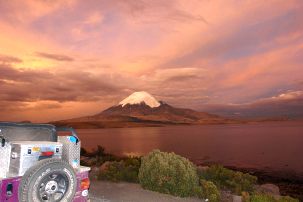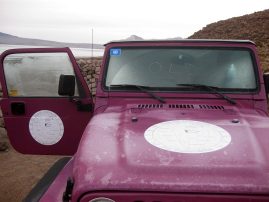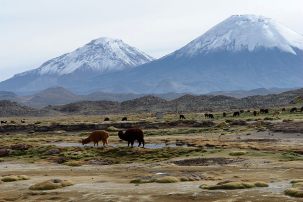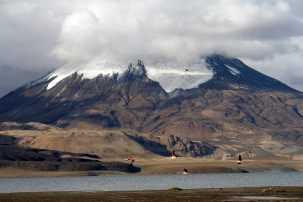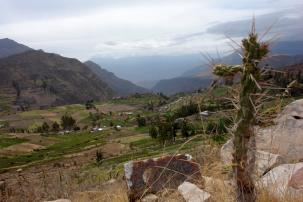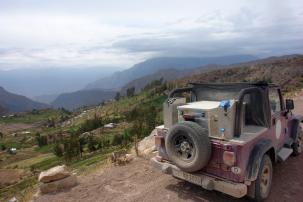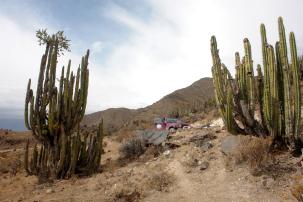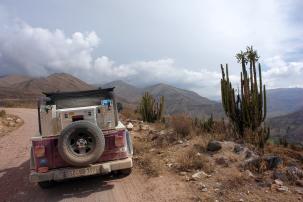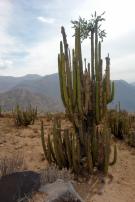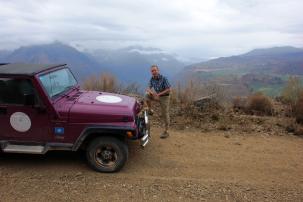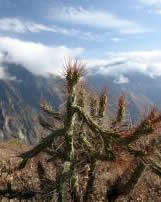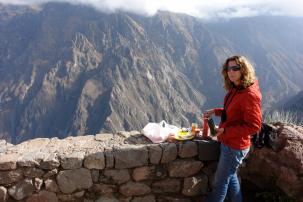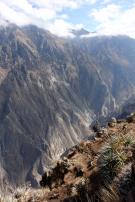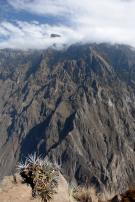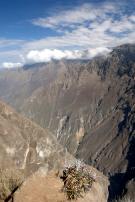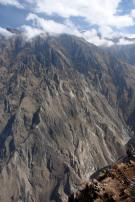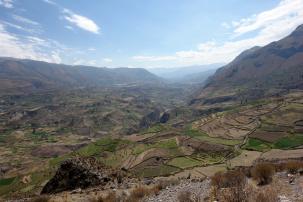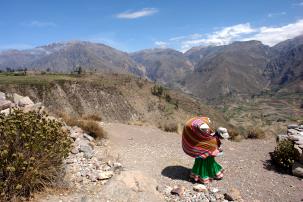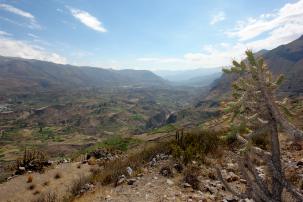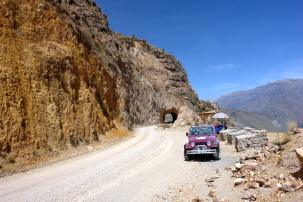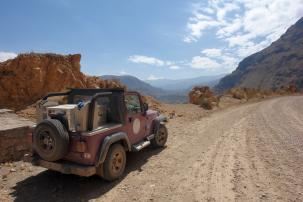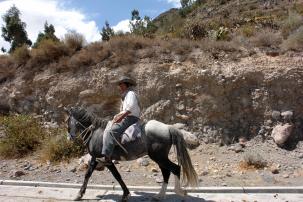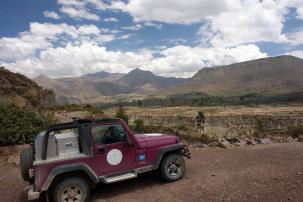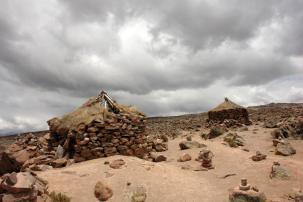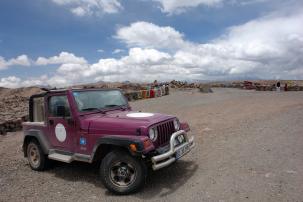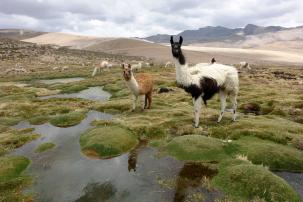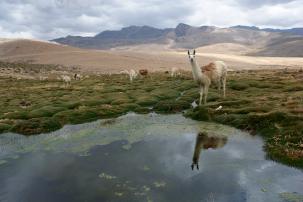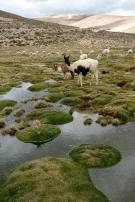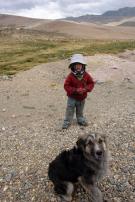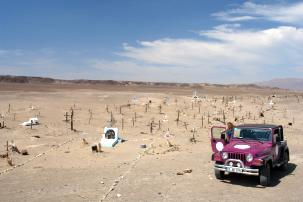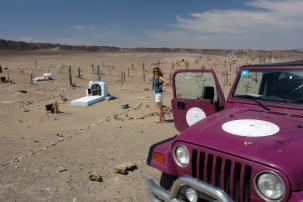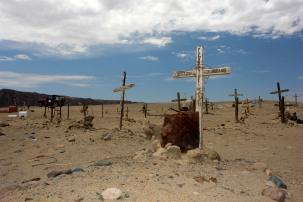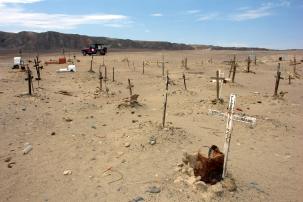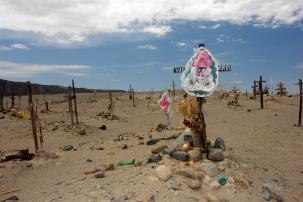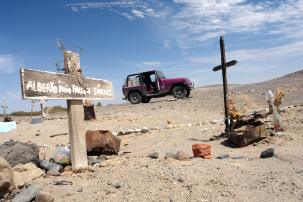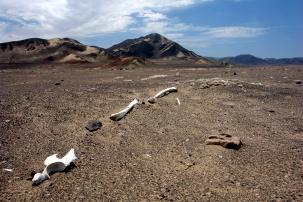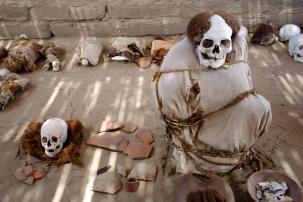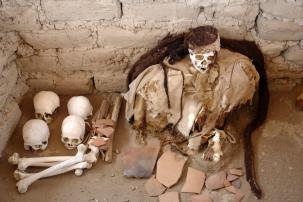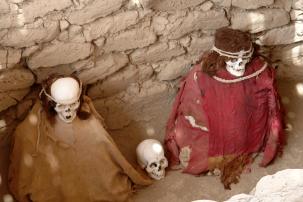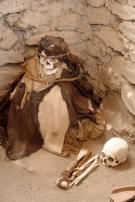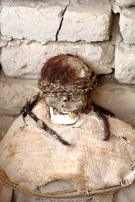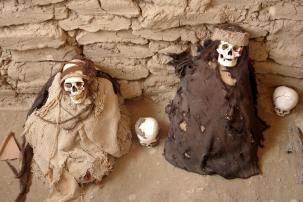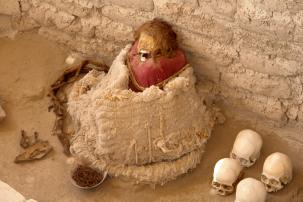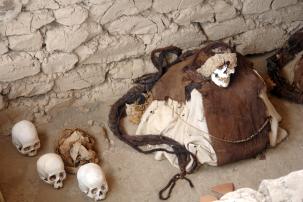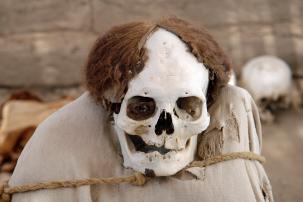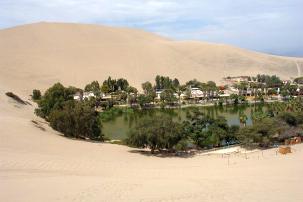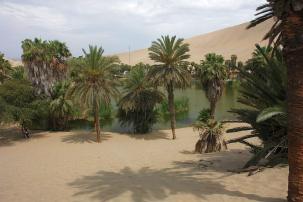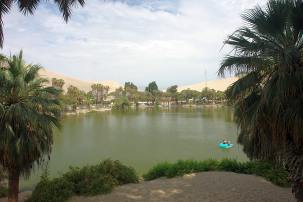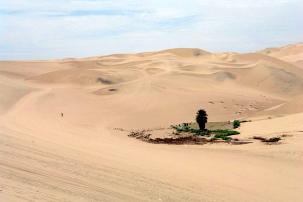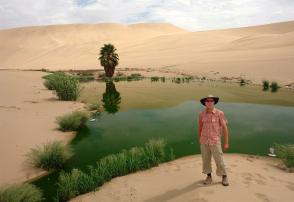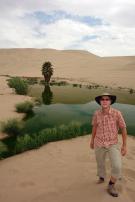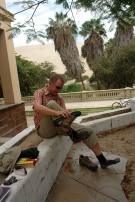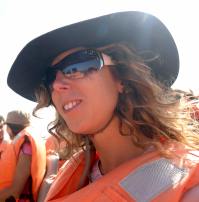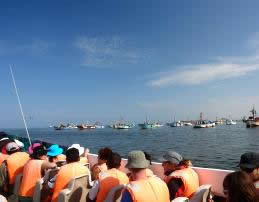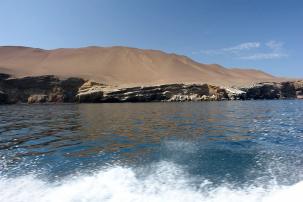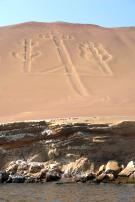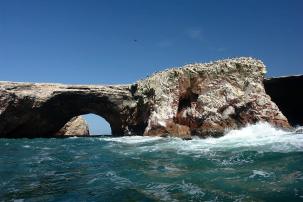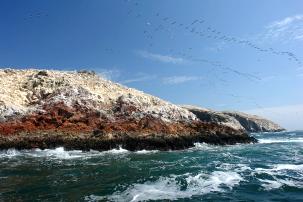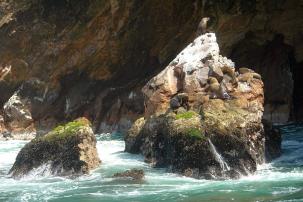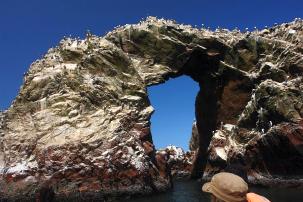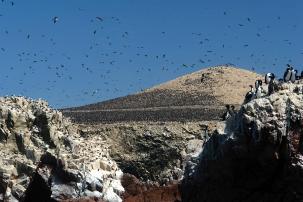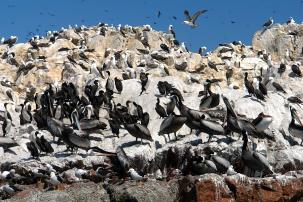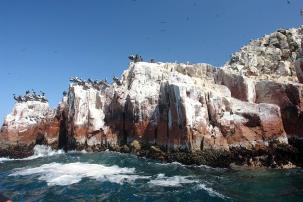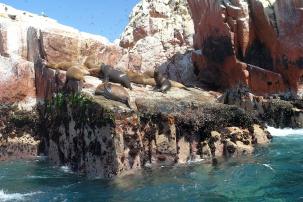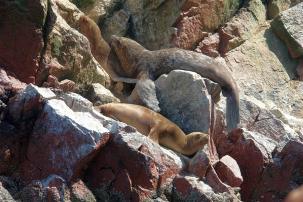Live Blog Page 05 - go to page 10 09 08 07 06 05 04 03 02 01
Tuesday 14.12.2010 - Volcan Isluga National Park with Salar de Surire, Geysirs Banos Puchuldiza, Chile
Dienstag 14.12.2010 - Volcan Isluga Nationalpark mit dem Salar de Surire, Geysire Banos Puchuldiza, Chile
The Volcan Isluga National Park includes the big Salar de Surire (salt lake of 17.500 hectars) where there is a mine for Borax on it. The workers were very happy to have tourists passing by rather than just trucks and enjoyed talking to us -as far as our Spanish allowed it. The Banos Puchuldiza geysirs were active when we arrived. The water becomes up to 85 degrees, however the pool for tourists was just lukewarm and could not make up for the cold in the air. So we skipped the bath.
Der Vulkan Isluga Nationalpark erfasst auch den grossen Salar de Surire (Salzsee von 17.500ha), wo es auch eine Boraxmine gibt. Die Arbeiter freuten sich, dass ausser den LKW's auch mal Touristen vorbeikamen und genossen es mit uns zu reden -soweit es unsere Spanischkuenste erlaubten. Die Banos Puchuldiza-Geysire waren auch aktiv als wir ankamen. Das Wasser wird bis zu 85 Grad heiss, obwohl der kleine Pool fuer Touristen nur lauwarm war. Deswegen und wegen der kalten Luft haben wir das Bad darin weggelassen.
Vulcan Gullatiri (6063m height), lot's of Lamas and Alpacas in the harsh mountain climate, Las Vicunas National Park, Chile
Vulkan Gullatiri (6063m), zahlreiche Lama- und Alpacaherden in dem lebensfeindlichen Bergklima, Las Vicunas Nationalpark, Chile
Church of Gullatiri, Las Vicunas National Park, Chile
Kirch von Gullatiri, Las Vicunas Nationalpark, Chile
Crossing Las Vicunas National Park, Chile
Fahrt durch den Las Vicunas Nationalpark, Chile
Nothern part of Salar de Surire - Salt mining, Las Vicunas National Park, Chile
Nördlicher Teil des Salzsee Salar de Surire - Salzabbau, Las Vicunas Nationalpark, Chile
Southern part of Salar de Surire, Las Vicunas National Park, Chile
Südlicher Teil des Salzsee Salar de Surire, Las Vicunas Nationalpark, Chile
Driving from Las Vicunas National Park to Volcan Isluga National Park, Chile
Fahrt vom Las Vicunas Nationalpark zum Volcan Isluga Nationalpark, Chile
Church in Isluga, Volcan Isluga National Park, Chile
Kirche von Isluga, Volcan Isluga National Park, Chile
Geysirs Banos Puchuldiza, Chile
Geysire Banos Puchuldiza, Chile
The last kilometers back towards the coast and to Huara, Chile
Die letzten Kilometer zurück and die Küste und nach Huara, Chile
Saturday 11.12.2010 - Arriving in Chile, Arica Beach, Starting our Semi-roundtrip in Chile's North: Lago (Lake) Chungara in Lauca National Park, Chile
Samstag 11.12.2010 - Ankunft in Chile, Strand von Arica, Start unserer Nordchile-Halb-Rundreise: Lago (See) Chungara im Lauca Nationalpark, Chile
When we finally arrived in Chile we took a day break to enjoy the Arica beach. From there we started our semi-roundtrip passing by the Geoglifos de Lluta and amazing nature on our way. We were especially impressed by Lago Chungara (on 4600 meters) with two volcanoes of over 6000meters height next to it. The area is within the Lauca National Park which has about 140.000 hectars. The park includes a safety zone for the wild vicunas although also the similar lamas and alpacas are taken there by their owners. After a few 'breathtaking' tries in this height Ben managed to get quite a few nice pictures of the animals. Unfortunately we had overestimated our adaptation to height thinking it would not be a problem to drive from sea level up to 4600m height.
Als wir endlich in Chile ankamen, legten wir einen Tag Pause am Strand von Arica ein. Von dort aus starteten wir unsere Halb-Rundreise, wobei wir die Geoglifos de Lluta sahen und wahnsinnige Aussichten geniessen konnten. Besonders eindrucksvoll war es am Lago Chungara (Hoehe 4600m), der von zwei 6000-er Vulkanen umgeben ist. Dieses Gebiet liegt im Lauca Nationalpark, der ca 140.000 Hektar gross ist. Der Park beinhaltet auch ein Schutzgebiet fuer die wilden Vicunas, obwohl die aehnlichen Lama- und Alpaca-Nutztiere dort auch weiden. Nach ein paar 'atemberaubenden' Versuchen in dieser Hoehe, schaffte es Ben ein paar wirklich schoene Bilder von den Tieren zu machen. Leider hatten wir unsere Hoehenangepasstheit ueberschaetzt und gedacht wir koennen problemlos von Meereshoehe auf 4600m
hoch fahren.
Drive from Arica at the coast to Lauca National Park and Volcan Isluga National Park, Chile
Fahrt von Arica an der Küste zum Lauca Nationalpark und Volcan Isluga Nationalpark, Chile
Lago (Lake) Chungara in Lauca National Park, Volcan Isluga National Park, Chile
Lago (See) Chungara im Lauca Nationalpark, Volcan Isluga Nationalpark, Chile
Sunset at Lago Chungara in Lauca National Park, Chile
Sonnenuntergang am Lago Chungara im Lauca Nationalpark, Chile
After a freezing cold and sleepless night at 4600m height at Lago Chungara
Nach einer eiskalten und schlaflosen Nacht in 4600m Höhe am Lago Chungara
Wednesday 08.12.2010 - Ride to Colca Canyon, Canyon and Condor Watching without Condors, Peru
Mittwoch 08.12.2010 - Fahrt zum Colca Canyon, Canyon und Kondor-Gucken ohne Kondore, Peru
The ride to Colca Canyon took us about two days. The Canyon itself is great, however we were by far not as impressed as by Bryce Canyon in the US last year. Watching condors was supposed to be the highlight of the trip. These animals can have a wing spread of up to three meters. Friends had warned us that arriving with the groups of tourists around 8.30am is too late and we'd have to be at the view point for 5.30am (!!). We could not (or maybe did not want to) believe in that and chose to be there for 7am.. Well, we stayed until the tourists came and left just before them around 9.30 after seeing one condor. How did that song go?!: 'It's like the good advice you just didn't take' - sorry Yvonne and Raphael for not following your advise!
Die Fahrt zum Canyon dauerte ca zwei Tage. Der Canyon selbst ist riesig, aber wir fanden ihn bei weitem nicht so imposant wie letztes Jahr den Bryce Canyon in den USA. Kondorbeobachtung sollte das Highlight dieses Ausflugs sein. Diese Tiere koennen Fluegelspannweiten von bis zu drei Metern haben. Freunde hatten uns gewarnt, dass es zu spaet ist mit den Touristengruppen um 8.30 Uhr am Aussichtspunkt anzukommen und wir muessten um 5.30 Uhr (!!) da sein. Wir konnten (oder wohl eher 'wollten') das nicht glauben und entschieden gegen 7 Uhr am da zu sein. Tja, wir blieben bis die Touristen kamen und fast bis sie wieder gingen und zogen gegen 9.30 ab ohne einen Kondor gesehen zu haben. Wie ging dieses Lied nochmal?!: 'It's like the good advice you just didn't take' -sorry Yvonne und Raphael! Wir haetten Euch einfach glauben sollen!
Waiting at the Colca Canyon for the Condors ...
Das Warten auf die Kondore im Colca Canyon ...
Leaving the Colca Canyon and heading South to Tacna.
Der Rückweg nach Süden Richtung Tacna.
Crossing two montains with more than 4500m height, saying hello to Tarapacas, Alpacas and Vicunas.
Auf dem Weg sind mehrere über 4500m hohe Pässe zu überqueren, trotz der dünnen Luft leben dort Tarapacas, Alpacas und Vicunas.
Wednesday 08.12.2010 - Cementario of Chauchilla, near Nasca, Peru
Mittwoch 08.12.2010 - Friedhof von Chauchilla, Nähe Nasca, Peru
After visiting the "current" desert cementario of Chauchilla, we went to the historic cementario with the old mummies in the middle of the desert. Really spooky! The mummies are pre-Inca and more than 1500 years old.
Neben dem "derzeitigen" Wüstenfriedhof von Chauchilla sind wir noch weiter zum historischen Friedhof mit den alten Mumien gefahren. Gruselig! Die Mumumien sind aus der vor-Inka Zeit und über 1500 Jahre alt.
Monday 06.12.2010 - Nasca Lines, Peru and Oasis of Huacachina, Peru
Montag 06.12.2010 - Nasca-Linien, Peru und Oase Huacachina, Peru
We decided to save money and view the Nasca lines from the watchtower at the Panamericana highway, also many flights were cancelled due to strong winds. However the next day we went to the Oasis of Huacachina. Climbing up the sand dunes was no fun at temperatures of more than 30 degress celcius!
Wir hatten uns entschieden auf einen Rundflug über die berühmten Linien von Nasca zu verzichten - die Preise waren sehr hoch und das Wetter mit starken Windböen alles andere als perfekt für einen Rundflug in einer kleinen alterschwachen Cessna. Am nächsten Tag sind wir dann zur Oase Huacachina, bei über 30 Grad im Schatten war das Hochklettern auf die Dünen alles andere als ein Spaß!
Monday 06.12.2010 - Semi-island of Paracas, Animal Watching at Islas Ballestas, Nasca Lines, Peru
Montag 06.12.2010 -Halbinsel von Paracas, Tierbeobachtungen bei den Islas Ballestas, Nasca-Linien, Peru
Seeing the desert on the Semi-island of Paracas was stunning. There are canyons with no vegetation at all right next to the sea. 'La Catedral', which was partly destroyed during an earth quake (it used to form a gate in the sea) a few years ago, is still impressive. There we already saw quite a few pelicanes and sea gulls. A trip to the Islas Ballestas was also on the plan: via speed boat we went to see 'El Candelabro', a 'drawn' candelabrocactus in a dune (similar to Nasca Lines), seals climbing way up high on the rocks, penguins and thousands of birds. Wow!
Die Wueste auf der Halbinsel Paracas hat uns die Sprache verschlagen. Direkt neben dem Meer sind Schluchten ohne jegliche Vegetation. 'La Catedral' ist immernoch beeindruckend, obwohl ein Erdbeben vor ein paar Jahren den Bogen ueber dem Meer zerstoert hat. Dort haben wir auch schon ein paar Pelikane und Seemoewen gesehen. Wir hatten auch einen Ausflug zu den Islas Ballestas auf dem Plan: Dabei ging es mit dem Speedboot zu 'El Candelabro', einer Einkerbung in die Sanddüne, die die Form eines Kandelaberkaktuses hat -ähnlich der Nascalinien. Dort waren auch dicke Seeloewen, die die grossen Steine nach oben gerobbt sind, Pinguine und tausende von Vögeln.
The islands were used in the past to get the Guano (the bird shit ...) which was used a a fertilizer for plants before artificial fertilizer was invented. Must have been a pretty "nice" job working on the islands - the Guano stinks like hell!
Die Inseln wurden in der Vergangenheit zum Abbau von Guano genutzt, vor der Erfindung von Kunstdünger wurde der Vogelmist als natürlicher Dünger verwendet. Jedoch kann man sogar von den Booten den Gestank kaum aushalten, also kein schöner Job auf den Inseln damals.
